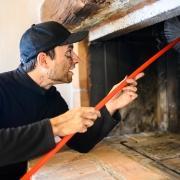What is Done During a Chimney Sweep?
During a chimney sweep, a professional will make sure that your chimney is clean and safe to use. They will use chemicals and products to clean the chimney. This helps to prevent fires from occurring and keep animals and birds away.
History of chimney sweeping
Hundreds of years ago, chimney sweeping was a hazardous job. The sweeps used a brush to scrape away the soot from the chimneys. The flues were narrow and dark. The sweeps would wedge their bodies into the flues. The sweeps would then slide down the chimney and then back up.
Children were also used to clean chimneys. The chimney sweeps were trained to remove the soot. They were usually small enough to fit through a trap door. The sweep would then use the brush to remove the soot from the chimney.
Child chimney sweeps were often forced into the trade. They were usually boys from poor families who were sold into the trade. These boys had to work for a fee to learn the trade. They would work non-stop.
They were often treated badly. Their feet would be stuck with pins to force them to work. They would eat poor food and work non-stop. They would also often get stuck in the flue. The soot would suffocate them.
Chemical products used by professional chimney sweeps
Whether you use a wood burning fireplace, pellet stove, or coal stove, you must periodically clean your chimney to maintain a clean and safe working environment. Excessive creosote in your chimney creates fire hazards and poses a health hazard.
Professional chimney sweeps use a variety of mechanical and chemical cleaning methods to remove creosote. These tools include brushes, vacuums, and chemical cleaning agents.
Brushes are the most common cleaning tool used by chimney sweeps. The brushes are made of a long, flat wire that is designed for strength and flexibility. They can be used in tight spaces and are good for scraping off gummy creosote.
Chemical chimney cleaning products work by removing creosote deposits through catalytic action. They include powders and sprays for application before ignition. They can also loosen creosote and soot deposits. They may not be effective for all types of chimneys, however, and may not be suitable for cleaning the flue surfaces.
Chimney sweeps also use other tools to remove creosote. They may use rotary cleaning to remove crusty creosote. They may also use stiff wire-bristle brushes to remove glazed creosote.
Routine chimney inspections can ensure your fireplace and chimney are safe to use
Having a professional chimney inspection performed on a regular basis will ensure that your fireplace and chimney are safe for use. These inspections will identify any problems, including blockages, leaking, and even leaks. This will help prevent damage and prevent expensive repairs.
A professional chimney inspection can save you money and stress. This is especially true if you have plans to sell or add an appliance to your system. You can also reduce your risk of a chimney fire or carbon monoxide poisoning.
A professional chimney inspection will also identify if there are any signs of damage or corrosion. This is important because acid corrosion can lead to structural deterioration in the chimney lining.
During a professional inspection, your chimney technician will check for missing mortar, cracks, and other design flaws. They will also check for creosote buildup, a flammable substance that increases your risk of fire.
If your chimney is over a century old, it may not be as efficient as it once was. This may lead to the release of harmful gases into your home. A professional chimney inspection will identify any problems and offer the best solution.
Keeping furry and feathered friends away
Keeping furry and feathered friends away during a chimney sweep is important. If an animal is trapped in your chimney, you may find that it leaves flammable and messy nesting materials behind. This can lead to smoke problems in your home and can restrict the airflow in your chimney. It can also cause your chimney system to be inefficient.
If you suspect an animal in your chimney, you should call a wildlife removal specialist right away. They will be able to remove the animal safely. If you destroy a songbird’s nest, you can be fined. The Migratory Bird Treaty Act protects songbirds from being destroyed. You don’t want to give these creatures unhealthy or toxic treats, as they are not picky eaters.
Keeping animals away from your chimney can be difficult, but there are steps you can take to make the process easier. These steps can include installing a chimney cap to prevent animal visits. You can also call a pest control company to help remove any stinging insects.






